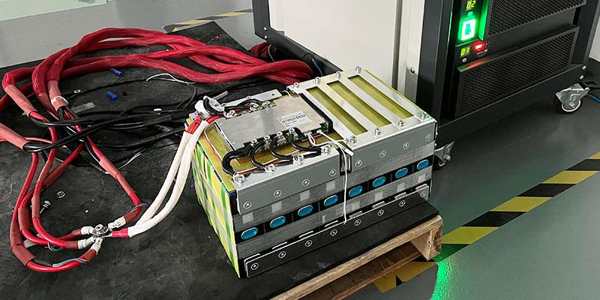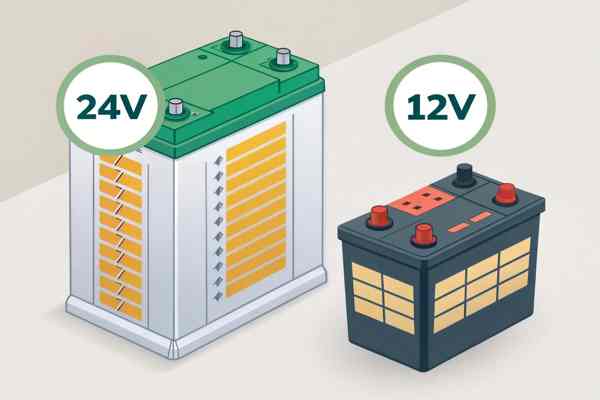¿Cuántas horas durará la batería de 24V 200Ah??
Cuando estás diseñando un sistema de energía fuera de la red, una aplicación marina, o una copia de seguridad robusta para su hogar, a menudo encontrarás el formato de batería de 24 V. Una pregunta común que escuchamos es, "¿Cuánto tiempo durará una batería de 24V 200Ah??" La respuesta es simple, Pero depende completamente de la cantidad de poder que estás usando.
Una batería de 24v 200Ah. 4,800 vatios-hora (¿Qué?) o 4.8 kilovatio-hora (kWh) de energía (24 Voltios x 200 Amp-horas). Cuánto tiempo dura depende de tu carga. Podría alimentar una carga continua de 480 vatios para aproximadamente 10 horas, o una carga más ligera de 200 vatios para casi 24 horas. Este cálculo supone que puede usar la capacidad total de la batería, que es un beneficio clave de la tecnología de batería de litio moderna.

En Gycx Solar, A menudo diseñamos sistemas alrededor de las plataformas eficientes de 24 V o 48 V utilizando LFP de alta calidad (Fosfato de hierro de litio) tecnología, A veces en un elegante 24V batería de litio de montaje en la pared Factor de forma. Explore cómo calcular el tiempo de ejecución y responder otras preguntas clave sobre estas potentes baterías.
¿Se pueden montar las baterías de litio en cualquier posición??
Cuando intentas colocar una batería en un espacio ajustado en un bote, en un vehículo, o en una casa compacta en Bangkok, flexibilidad de instalación1 es una gran ventaja. Entonces, ¿Está restringido a mantener la batería de litio en posición vertical??
Sí, la mayoría de las baterías de litio selladas modernas, incluyendo tipos de 24 V LFP, se puede montar en cualquier posición—Verticalmente, horizontalmente, o de su lado. Esta es una gran ventaja sobre las baterías tradicionales de ácido de plomo inundado, que debe mantenerse en posición vertical para evitar que el ácido corrosivo se filtre. El sellado, La naturaleza de estado sólido de las células de litio es lo que hace que los diseños innovadores sean como baterías de montaje en la pared posible y seguro.

Sumergirse: Libertad de electrolito líquido
He aquí por qué el litio ofrece esta flexibilidad:
- Sellado por diseño: Las celdas internas de la batería (ya sea prismático o de la bolsa) están completamente sellados. El electrolito no es un líquido de flujo libre, sino que es una sustancia en forma de gel o se absorbe completamente en un material separador.
- Estructura interna sólida: Los componentes se fijan de forma segura y no se ven afectados por su orientación en relación con la gravedad. Esto los hace inherentemente más resistentes a la vibración y el choque también..
- Habilitar factores de forma modernos: Esta libertad de diseño permite:
- Baterías de montaje en la pared: Instalado verticalmente en una pared para ahorrar un espacio precioso en el piso, un gran beneficio en apartamentos o hogares modernos.
- Baterías de estante compactas: Instalado horizontalmente en denso, estantes de equipos que ahorran espacio.
Esta versatilidad nos permite en GYCX Solar para diseñar un limpiador, más seguro, y sistemas de energía más integrados que encajan perfectamente en los espacios únicos de nuestros clientes.
¿Cuánto tiempo tendrá un 50h de 24V?, 100ah, o la batería de litio de 200ah al final?
Estás buscando diferentes capacidades de batería de 24 V e intentando decidir cuál es el adecuado para ti.. ¿Cómo es el tiempo de ejecución de un 50Ah?, 100ah, y la batería de 200AH realmente se compara en el mundo real?
El tiempo de ejecución es directamente proporcional a la hora del amplificador (ah) clasificación. Para la misma carga, a 100AH La batería durará el doble que una batería de 50Ah, y una batería de 200Ah durará cuatro veces más larga. La clave es convertir primero la calificación de la batería en horas de vatio (¿Qué?), que representa la energía total almacenada.

Sumergirse: Las matemáticas simples del tiempo de ejecución de la batería
Vamos a caminar por lo fácil, cálculo de dos pasos:
Paso 1: Calcule la energía total en horas de vatios (¿Qué?)
La fórmula es: Energía (¿Qué?) = Voltaje (V) x capacidad (ah)
- Para una batería de 24V 50Ah: 24V x 50AH = 1,200 ¿Qué? (o 1.2 kWh)
- Para una batería de 24V 100Ah: 24V x 100AH = 2,400 ¿Qué? (o 2.4 kWh)
- Para una batería de 24V 200Ah: 24V x 200AH = 4,800 ¿Qué? (o 4.8 kWh)
Paso 2: Calcule el tiempo de ejecución en función de su carga
La fórmula es: Tiempo de ejecución (Horas) = Energía total (¿Qué?) / Tu carga (en vatios)
Usemos un ejemplo práctico de una pequeña configuración fuera de la red o escenario de copia de seguridad con una carga continua de 150 vatios (p.ej., un pequeño refrigerador eficiente, un par de fanáticos, y algunas luces LED).
| Tamaño de batería | Energía total | Tiempo de ejecución para una carga de 150W |
|---|---|---|
| 24En 50Ah | 1,200 ¿Qué? | 1200 ¿Qué? / 150W = 8 horas |
| 24En 100Ah | 2,400 ¿Qué? | 2400 ¿Qué? / 150W = 16 horas |
| 24En 200ah | 4,800 ¿Qué? | 4800 ¿Qué? / 150W = 32 horas |
Esta tabla muestra claramente cómo duplicar la capacidad AH duplica directamente su tiempo de ejecución. En Gycx Solar, Le ayudamos a realizar un análisis de carga para determinar la capacidad adecuada para su autonomía deseada..
¿Cuál es la diferencia entre 12V 100Ah y 24V 100Ah Battery??
Esta es una excelente pregunta que llega al corazón del diseño del sistema.. Ves dos baterías, Ambos clasificados a 100AH, Pero uno es 12V y el otro es de 24V. ¿Proporcionan la misma cantidad de energía??
A 24V 100AH Batería almacena el doble de energía total (2,400 Vatio) como 12V 100AH BATERÍA (1,200 Vatio). Un sistema de 24 V también es generalmente más eficiente para alimentar cargas más grandes porque se ejecuta a una corriente más baja (amperios), que permite el uso de más delgado, Cableado menos costoso y reduce la pérdida de energía en los cables.

Sumergirse: Por qué importa el voltaje
Desglosemos estas dos diferencias clave:
- Energía almacenada total (Vatio): El amperio-hora (ah) La calificación es solo la mitad de la historia. La verdadera medida de la energía son las horas de vatio.
- 12V 100AH BATERÍA: 12 Voltios x 100 Amp-hora = 1200 ¿Qué?
- 24V 100AH BATERÍA: 24 Voltios x 100 Amp-hora = 2400 ¿Qué?
La batería de 24 V contiene el doble de energía y proporcionará el doble de tiempo de ejecución para la misma carga de vatios, a pesar de que tienen el mismo "100Ah" clasificación.
- Eficiencia del sistema (Actual): Fuerza (Vatios) = Voltaje (V) x corriente (Amperios). Esto significa para una demanda de energía dada, Un sistema de voltaje más alto dibujará menos corriente.
- Ejemplo: Para alimentar un inversor de 1200 vatios:
- En un sistema de 12V: 1200W / 12V = 100 Amperios de corriente.
- En un sistema de 24 V: 1200W / 24V = 50 Amperios de corriente.
- ¿Por qué es mejor la corriente más baja?? La corriente alta requiere muy gruesa, pesado, y costosos cables de cobre para manejar la carga de forma segura. Bajando la corriente a la mitad (mediante el uso de un sistema de 24 V) le permite usar un cableado significativamente más pequeño y más asequible. También reduce la cantidad de energía perdida como calor en los cables, hacer que todo el sistema sea más eficiente.
- Ejemplo: Para alimentar un inversor de 1200 vatios:
Cuándo elegir 24V? Para cualquier sistema con cargas moderadas a grandes, A 24 V (o 48V para sistemas caseros aún más grandes) La configuración es generalmente superior al sistema de 12 V en términos de eficiencia y costo del cableado. Nuestro 24V batería de litio de montaje en la pared Las soluciones son perfectas para aplicaciones de tamaño mediano que necesitan este equilibrio de energía y eficiencia.
Solar Gycx Historia: "A menudo trabajamos con los dueños de botes aquí en Bangkok. Para barcos más pequeños, Un sistema de 12V está bien, Pero para recipientes más grandes con aire acondicionado y refrigeración, Siempre recomendamos un sistema de 24 V. Las ganancias de eficiencia y los tamaños de cables más pequeños son una gran ventaja en un entorno marino."
Comprender el tiempo de ejecución de su batería es un cálculo simple basado en su energía almacenada total (En vatios-hora) y el impulso de poder de tus electrodomésticos. Las baterías de litio selladas modernas le dan la flexibilidad de montarlas en cualquier posición, haciendo elegante 24V batería de litio de montaje en la pared sistemas un ideal, solución para salvar el espacio. Eligiendo el voltaje del sistema correcto, Como 24 V, También puede obtener ventajas significativas en la eficiencia.
Si tiene preguntas sobre el tamaño de una batería para sus necesidades específicas o desea explorar los beneficios de un sistema de energía de 24 V diseñado profesionalmente, Nuestro equipo de expertos en GYCX Solar está aquí para ayudar. Contáctenos para una consulta!
Comprender la flexibilidad de la instalación puede ayudarlo a optimizar la colocación de la batería en espacios ajustados. ↩
